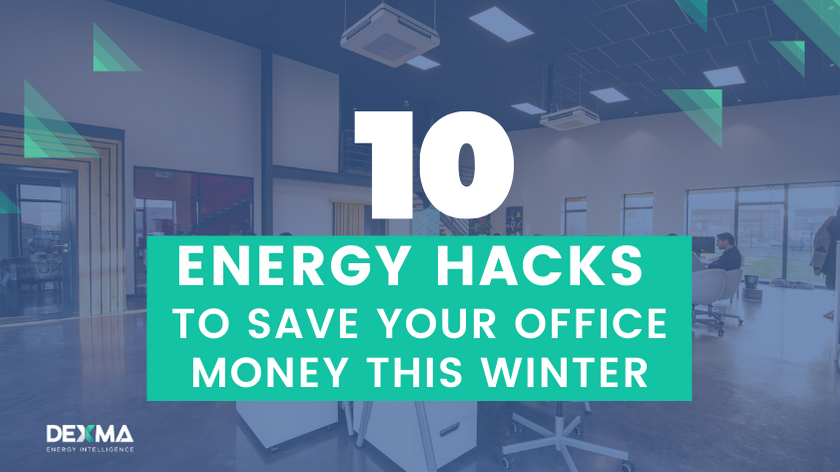Did you know that more than half of senior business managers have no idea how their companies buy energy? Ouch. And nearly 50% also confess to a “limited understanding” of how much energy costs their business, according to a recent YouGov survey of more than 750 senior executives across the UK.
Although 1/5th of survey participants knew that their company spends more than £250,000 on energy every year, 54% of senior managers had “no idea” who is actually responsible for buying that energy!
In light of these troubling results (pun 100% intended), let’s take a deeper look into how senior managers can tackle these rising energy costs, especially now that “Winter Is Coming”. To save money this winter, businesses need to be more proactive about how and when they consume energy – and for most of them, that usually means starting in the office.

Hacking Energy Consumption in Office Buildings
Typically, energy consumption accounts for up to 19% of the total operating costs of large office buildings.
To give you a general idea of how that energy is consumed, let’s take a look at the consumption breakdown for the average office building. Lighting is the main culprit, consuming nearly half of all the energy in your typical office building. Cooling, ventilation and IT equipment also tend to use up lots of energy.
Of course, not all offices are created equal, and some activities naturally require more energy than others. Although no silver bullet solution exists to guarantee energy efficiency for every office building, certain actions can be taken depending on your building’s characteristics. Before you start with energy hacks, however, you need some kind of diagnostic report, sometimes known as an energy audit.
1. Get personalised energy insights – hardware free
Energy audits can be really expensive if done on-site, and most companies don’t have the time or resources to spend on energy efficiency in the first place.
That’s why we built DEXMA Detect – a data-driven energy insights platform that calculates your building’s savings potential without the need to install any metering hardware. By anonymously comparing the electricity bill of your building with data from similar buildings, anyone can quickly and easily understand how much electricity and money their business can save.
Looking at existing DEXMA Detect data, our team of Experts found that on average, office buildings can generate 37.4% in potential energy savings – and that’s just for electricity! (Are you forgetting about gas and thermal sources? Tsk tsk! More about that here.)
To get a personalised energy savings recommendations and understand how much your building can save, ask for a personalised demo.
2. Someone Please Cut the Lights
It’s time to start taking steps to cut your consumption. Here’s your first mission: outside office hours, take a walk starting from the top of your building. Go floor by floor and count how many lights could reasonably be turned off at this time. Now, multiply that number by 22.77* – that’s your estimate of how much money you can save per year just by keeping those lights off.
3. Let the Sunshine In
Making the best use possible of natural light is another important strategy for reducing energy costs. Check public spaces in your office building for their light-to-window ratio. Turn off the lights and see if the room still seems well-lit. If so, count how many lights there are and multiply that number by 2.84 – this will give you an estimate on how much you can save by turning on the lights only one hour later.
4. Get More Sleep
Adjusting the power settings for computers, printers and coffee machines – ubiquitous equipment in office buildings – can yield significant savings in annual energy consumption. Simply setting your office computers to enter sleep mode after 5 minutes of inactivity can generate savings of around $75 per computer per year.
Outside office hours, walk around the building counting how many computer screens you see on. Multiply this number by 10.51, and you get how much energy you can save by turning off the screens when they are not used.
5. Hack Your Heating
Heating and cooling equipment are big energy vampires. Try to turn heating or cooling systems off one, or even half an hour before the end of the working day. The total energy saved by this hack can reach around 5%, without spending a penny or sacrificing comfort.
6. No Filter?
Check all the filters of the air conditioners are clean, and if the heaters are set to the right temperature. We get that you might not have access to get this one done, so book a meeting with the maintenance staff for the HVAC system, and ask them about the planned maintenance for the next year. The system should be checked at least twice a year and the filters must be replaced, along with other components, no less than once a year.
Getting Serious About Saving Energy
We’ve covered the most effective short term hacks, but for guaranteed savings you’re going to have to dedicate a little extra time and money. While long-term actions to increase energy efficiency in offices tend to require additional efforts, the return of investment or payback usually comes within a year, in the form of savings.
7. Commission an On-Site Energy Audit
This is a process in which the building’s processes are analysed and verified by an energy services company to see if they are running as efficiently as possible. It involves a great deal of monitoring and optimisation, but the payback period is usually less than one year in form of savings – which can cover from 10 to 15% of your company’s electricity bill. Here you can search for an ESCO near you that offers energy auditing services.
8. Replace fluorescent lights for LEDs
This hack also requires considerable investment but yields massive savings. Figure out which lighting technology is the most suitable for your building, considering the lifespan, energy efficiency and light distribution necessary for all ambiences. Replacing fluorescent lights with LEDs for example can lead to a 35% reduction in energy consumption. If you need more arguments to convince your CFO that energy efficient LED lighting is a worthy investment, find them here.
9. Motion-Controlled Lighting
Installing motion sensors to control lighting in different parts of the office building can help you save big time. This is especially true for parking lots, which tend to be overlit and wasteful when it comes to electricity.
For instance, a parking lot with 30 lights of 60W consumes 1.8kW of energy. If the lights stay on for an average of 12 hours per day, that’s €56,160 per year (!) However installing a sensor for just 15 lights to stay off 50% of the time reduces your energy cost to €42,120 – a 25% reduction.
10. DCV for HVAC
Another way to guarantee some savings is implementing a demand-controlled ventilation (DCV) system for your HVAC. DCVs work by sensing the occupancy of each room, usually by measuring C02 levels, and then adjusting ventilation levels accordingly.
These are just a few actions that you can take to increase the energy efficiency of your office building this winter. Remember, the crucial first step is to get a data-driven idea of what level of energy savings you can expect.
Learn more about how DEXMA Detect can expedite the process for you in our Webinar recording about Automatic Detection of Energy Savings:





